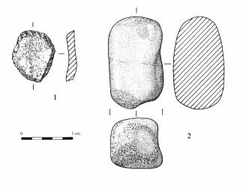Excavations at Spratsgate Lane, Somerford Keynes, Gloucestershire
Gloucestershire County Council, 2007. https://doi.org/10.5284/1000012. How to cite using this DOI
Data copyright © Gloucestershire County Council unless otherwise stated
This work is licensed under the ADS Terms of Use and Access.
Primary contact
Jo
Vallender
Archaeology Service
Gloucestershire County Council
Shire Hall
Westgate Street
Gloucester
GL1 2TH
England
Tel: 01452 425681
Fax: 01452 425356
Resource identifiers
- ADS Collection: 775
- ALSF Project Number: 3213
- DOI:https://doi.org/10.5284/1000012
- How to cite using this DOI
Introduction

Gloucestershire County Council Archaeology Service carried out a programme of archaeological investigation between 1989 and 1996 at Spratsgate Lane, Somerford Keynes, Gloucestershire. This took the form of two seasons of evaluation, in 1989 and 1990 (Parry 1990), and two seasons of excavation, in 1995 and 1996. The application for planning permission to extract sand and gravel at Spratsgate Lane predated the introduction of Planning Policy Guidance 16 in 1990. As a consequence, although funding for the evaluation and excavations was obtained from the developer, the post-excavation work and publication of the results were funded by English Heritage through the Aggregates Levy Sustainability Fund (ALSF).
The excavations at Spratsgate Lane produced evidence of limited Bronze-Age and extensive Middle Iron-Age activity, comprising two areas of settlement, one enclosed. A ditch defined the enclosed settlement to the west, and its line was interrupted by two gateways, one of which had structural evidence for wooden posts, and these gave access to two areas of activity. Outside the boundary, and directly in front of the northern gate, the reamins of a well was recorded. Each area of activity centred on a circular enclosure, approached by a ditched trackway. These central areas have been interpreted as evidence for house structures and associated with them were structures representing extensions and delineating possible livestock paddocks. The layout is suggestive of a small Middle Iron-Age village with evidence for field systems to the west, south and east. The settlement may be part of a much wider community of Middle Iron-Age activity which extended into areas recently excavated at Cotswold Community and Shorncote Quarry to the north and east. Evidence from the excavations at these three sites indicates an economy dependant on animal husbandry, predominantly cattle and sheep, and trading widely for other necessities such as salt from Droitwich, pottery from the Malvern area and perhaps grain. The environment appears to have comprised essentially open ground and areas of scrub, with stands of water probably within the ditches associated with the settlement, fresh water was also likely to have been located nearby. Water shortages appeared to have occured occasionally necessitating the digging of wells.







